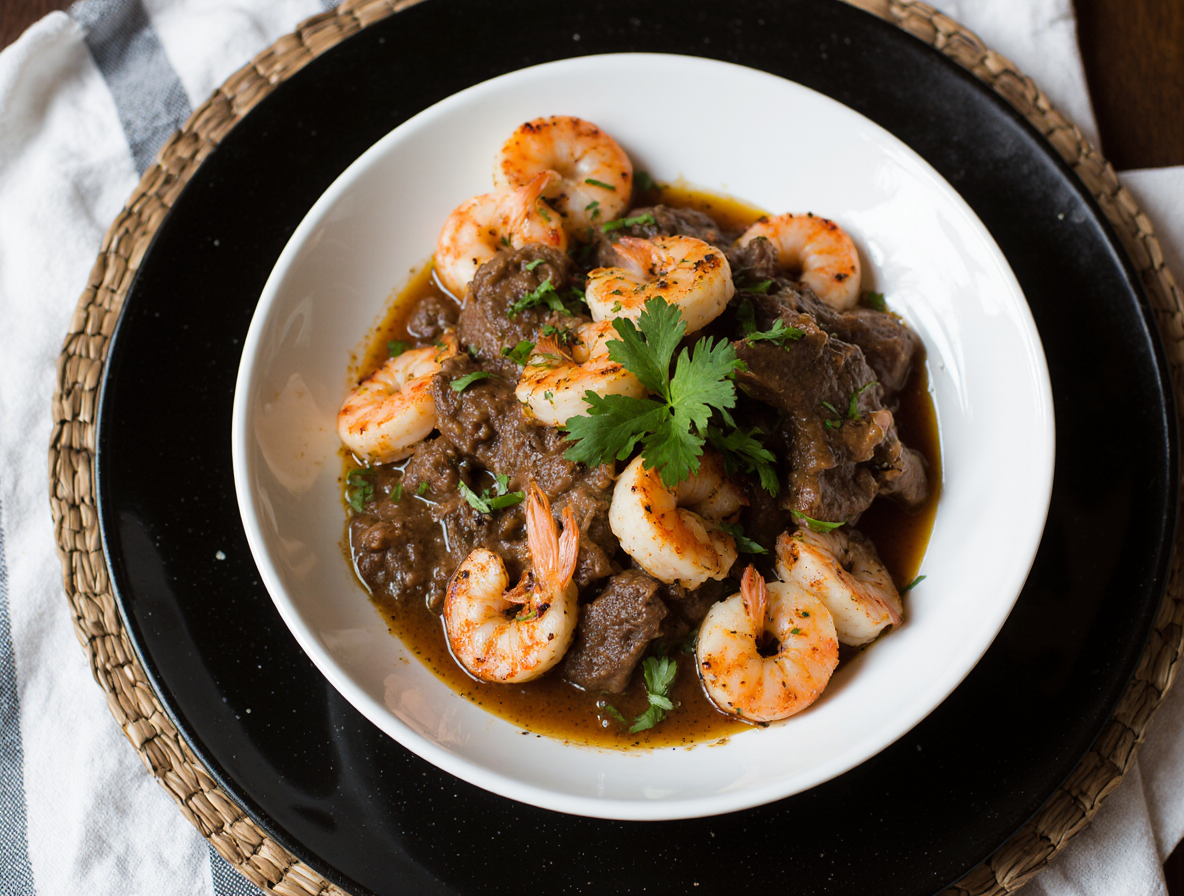Perfect Shrimp and Steak Stir Fry: A 20-Minute Restaurant-Quality Dinner
When you need a protein-packed dinner in minutes, shrimp and steak stir fry delivers an impressive 55g of protein per serving. This delicious land-and-sea combo combines two favorite proteins into one satisfying meal that’s ready in under 20 minutes, making it perfect for those busy weeknights when you’re craving something indulgent yet practical.
Additionally, our steak and shrimp stir fry recipe offers the best of both worlds – restaurant-quality flavor without the restaurant wait. Not only is this steak and shrimp stir fry loaded with healthy fats and low-carb vegetables, but it also brings together the boldness of savory steak with the sweet, briny snap of shrimp. We love how customizable these steak and shrimp recipes are, allowing you to adjust ingredients based on what you have available.
Throughout this guide, we’ll walk you through everything you need to know to create the perfect shrimp steak stir fry – from selecting the right cuts of meat to mastering the quick cooking technique over high heat that makes stir-frying so efficient. Whether you’re new to stir-frying or looking to perfect your technique, our shrimp and steak stir fry recipe will become your new go-to meal solution.
Why This Shrimp and Steak Stir Fry Works So Well
There’s a reason shrimp and steak stir fry has become a favorite meal solution for busy home cooks. This brilliant combination delivers restaurant-quality results with minimal effort, making your weeknight dinners both exciting and efficient.
Quick and easy for weeknights
The beauty of a steak and shrimp stir fry lies in its simplicity. Unlike complex dishes that require hours of preparation, this meal comes together in just 20 minutes. The stir-fry cooking method ensures quick and efficient preparation, making it ideal for those hectic evenings when time is limited. Furthermore, everything cooks in a single pan, meaning cleanup is just as quick as the cooking process.
The key to success is having all ingredients prepped before heating your pan. This prep-ahead approach ensures the actual cooking flows smoothly once you begin, since stir-frying happens at rapid speed over high heat. Consequently, you’ll spend less time in the kitchen and more time enjoying your delicious creation.
High protein and low prep
A single serving of steak and shrimp stir fry delivers an impressive 55g of protein, making it an excellent choice for maintaining muscle and supporting overall health. The nutritional profile doesn’t stop there – this dish provides essential nutrients from both land and sea sources.
Specifically, the protein combination works remarkably well:
- Beef contributes iron, zinc, and B vitamins
- Shrimp adds heart-healthy omega-3 fatty acids
- Together they create a balanced amino acid profile
Meanwhile, the prep work remains minimal compared to the nutritional payoff. With just a few minutes of chopping and ingredient organization, you’ll have everything ready for a nutrient-dense meal that satisfies hunger and supports your health goals.
Customizable with your favorite veggies
Perhaps the most appealing aspect of shrimp steak stir fry is its incredible versatility. In essence, it’s a foundation you can build upon with whatever ingredients you have available.
Notably, you can use virtually any vegetable, including snow peas, green beans, mushrooms, onions, sugar snap peas, or green onions. This flexibility allows you to adapt based on seasonal availability, family preferences, or simply what needs using up in your refrigerator.
The customization options extend beyond vegetables. You can adjust the sauce ingredients, try different cooking oils, or even swap in alternative proteins if needed. Above all, this adaptability makes steak and shrimp stir fry a practical solution for creating nutritious, delicious meals with whatever ingredients you have on hand.
Essential Ingredients and Smart Substitutions
Creating the perfect shrimp and steak stir fry begins with selecting the right ingredients, with thoughtful substitutions ready when needed. Here’s what you’ll need for restaurant-quality results at home.
Best steak cuts for stir fry
Flank steak stands out as arguably the most suitable cut for stir-frying thanks to its lean composition, rich beefy flavor, and tender texture when properly prepared. Sirloin offers similar qualities while being more affordable than premium cuts. Skirt steak provides robust flavor and works wonderfully when marinated before cooking.
For budget-conscious cooks, chuck steak delivers surprising tenderness when thinly sliced against the grain. In fact, in side-by-side tests, chuck steak proved comparably tender to sirloin and scotch filet despite costing significantly less—just $3.75 compared to $16.00 for eye filet.
Nevertheless, if you’re looking to splurge, beef tenderloin creates an exceptionally juicy stir fry, though be careful as it can break apart during cooking.
Choosing the right shrimp
Unless you have access to a trusted fishmonger, frozen shrimp often provides better quality than “fresh” shrimp displayed on ice, which may have been thawed and sitting out for days. Always check labels for additives—”shrimp” should be the only ingredient listed.
Size matters when selecting shrimp. Look for count numbers like 16/20 (larger) or 31/35 (smaller), indicating how many shrimp make up a pound. Medium shrimp (51-60 per pound) work particularly well in stir fries as they’re perfectly bite-sized.
Vegetables that add crunch and color
The beauty of stir fry vegetables lies in their flexibility. Traditional options include broccoli, bell peppers, sugar snap peas, and carrots for their crisp texture and visual appeal. For authentic Asian flavors, consider bok choy, water chestnuts, or baby corn.
When substituting vegetables, remember that crispy textures work best. Therefore, if a recipe calls for bamboo shoots, water chestnuts make an excellent alternative, adding similar crispness and mild sweetness.
Sauce ingredients that bring it all together
A balanced stir fry sauce typically contains:
- Low-sodium soy sauce (regular can make dishes too salty)
- Sesame oil for nutty depth
- Rice vinegar for tangy brightness
- Garlic and ginger for aromatic foundation
- Cornstarch to thicken and create glossy coating
- Sweetener (honey, brown sugar) to balance flavors
If you’re missing ingredients, smart substitutions work well—use tamari for soy sauce, apple cider vinegar for rice vinegar, or cornstarch alternatives like arrowroot powder or potato starch in equal amounts.
Step-by-Step: How to Make the Perfect Stir Fry
Success in preparing shrimp and steak stir fry relies as much on proper technique as quality ingredients. Mastering these four critical steps will guarantee restaurant-worthy results every time.
1. Marinate the steak for flavor and tenderness
Never skip this crucial step. Marinating your steak is absolutely essential for achieving tender, flavorful meat in your stir fry. Combine soy sauce, sesame oil, minced garlic, and ginger in a resealable bag with your thinly sliced steak. For best results, marinate for at least 30 minutes, though 4+ hours yields optimal tenderness. The marinade serves multiple purposes: salt and soy sauce tenderize the meat, sugar improves browning, oil distributes flavors, and cornstarch creates a protective coating that prevents overcooking.
2. Prep and cook the vegetables
Before heating your pan, complete all vegetable prep – this technique (called mise en place) ensures smooth cooking once you start. Cut vegetables into similar-sized pieces for even cooking. When it’s time to cook, add 2 teaspoons oil to your hot pan, then add vegetables in stages based on cooking time. Start with firmer vegetables like carrots and broccoli, cooking until they begin to soften. Next, add quicker-cooking vegetables like bell peppers and onions. For crisp-tender texture, avoid overcooking – vegetables should retain vibrant colors and slight crunch.
3. Sear the steak and shrimp separately
Heat your wok or skillet until it’s smoking hot – proper temperature is critical for searing rather than steaming. First, cook your marinated steak in a single layer without stirring for about a minute to develop caramelization. Once browned on both sides (approximately 3 minutes total), remove and set aside. Subsequently, add the shrimp to the same pan, cooking just until they curl into a ‘C’ shape and turn pink (about 1-2 minutes). Cooking proteins separately prevents overcrowding and ensures each reaches perfect doneness without compromising texture.
4. Combine everything with sauce and finish
Prepare your sauce by whisking together soy sauce, broth, sugar, and cornstarch. Return your vegetables to the hot pan, then pour in the sauce around the sides of the wok. As the sauce begins to simmer, it will thicken and become glossy within 1-2 minutes. Finally, return the steak and shrimp to the pan, gently combining everything to coat with sauce. Avoid extended cooking at this stage – just heat through for about a minute to preserve the texture of your perfectly cooked proteins and vegetables.
Tips, Variations, and Storage
Even the most perfectly prepared shrimp and steak stir fry can benefit from a few professional tricks. Master these final touches to elevate your stir fry from good to extraordinary.
Avoid overcooking shrimp and steak
The number one rule for perfect shrimp and steak stir fry is proper timing. Shrimp cooks in just 2 minutes, so consider setting a timer to prevent rubbery results. Look for visual cues: properly cooked shrimp curls into a “C” shape, whereas overcooked shrimp curls into an “O” shape.
For steak, velveting is your secret weapon. This Chinese technique involves marinating meat in oil, cornstarch and seasonings before cooking. The cornstarch creates a protective barrier that keeps your beef juicy. When cooking proteins, remember they’ll continue cooking briefly after removal from heat, so aim for slightly under rather than over.
Try different sauces like teriyaki or garlic butter
Experiment with various flavor profiles to keep your shrimp and steak stir fry exciting. Teriyaki glazed “surf and turf” creates a delightful Japanese fusion – make your own by combining soy sauce, rice vinegar, brown sugar, sesame oil, and garlic. For heat lovers, add red pepper flakes or sriracha.
Alternatively, try garlic butter sauce for rich indulgence or explore Asian BBQ, Mongolian, or Korean BBQ sauces. Making sauces ahead saves time – they’ll keep in the refrigerator for up to 1 week or frozen for up to 3 months.
How to store and reheat leftovers
First, allow leftovers to cool briefly before transferring to airtight containers. Refrigerate for 3-4 days or freeze for 3-4 months. When reheating, aim for food safety by ensuring the internal temperature reaches 165°F.
For stovetop reheating, use medium heat and add a splash of broth or water to prevent dryness. Alternatively, microwave in 30-second intervals, stirring between each. To revive flavors in leftover stir fry, add a drop of sesame oil, a dash of soy sauce, or a touch of rice vinegar during reheating.
Conclusion
Shrimp and steak stir fry stands as a brilliant solution for anyone seeking a protein-packed meal without spending hours in the kitchen. Throughout this guide, we’ve explored how this versatile dish delivers restaurant-quality results in just 20 minutes, making it perfect for busy weeknights when you crave something special but practical.
We love this recipe because it truly offers the best of both worlds – the bold flavors of savory steak alongside the sweet, briny snap of perfectly cooked shrimp. Additionally, the high protein content (55g per serving) makes this dish both satisfying and nutritious, while the cooking technique ensures maximum flavor with minimal effort.
Your success with this dish depends largely on following the key steps we’ve outlined. First, never skip marinating your steak – this crucial step ensures tenderness and depth of flavor. Second, proper preparation of all ingredients before cooking allows the actual stir-frying to proceed smoothly. Finally, cooking proteins separately prevents overcrowding and guarantees perfect doneness for both the steak and shrimp.
Perhaps most importantly, this stir fry recipe serves as a flexible framework rather than a rigid formula. You can easily adapt it based on available ingredients, dietary preferences, or simply what needs using up in your refrigerator. Different sauce variations like teriyaki or garlic butter offer endless possibilities for keeping this dish exciting meal after meal.
Next time you face the “what’s for dinner” dilemma, remember this shrimp and steak stir fry. With its winning combination of speed, nutrition, and incredible flavor, it might just become your new go-to meal solution. After all, few dishes manage to deliver so much satisfaction with so little fuss – a true culinary win for busy food lovers everywhere.
FAQs
Q1. What’s the key to making a delicious stir fry? The secret lies in proper preparation and technique. Marinate your meat for flavor, cut ingredients uniformly, use high heat, and cook proteins separately. Add vegetables in stages based on cooking time, and finish by combining everything with a flavorful sauce.
Q2. How can I ensure my shrimp stays tender in a stir fry? To achieve tender shrimp, avoid overcooking. Cook shrimp just until they curl into a “C” shape and turn pink, which usually takes only 1-2 minutes. Remove them from heat promptly to prevent them from becoming rubbery.
Q3. Is it safe to cook steak and shrimp together? Yes, you can cook steak and shrimp together, but it’s best to cook them separately and combine at the end. This ensures each protein is cooked to perfection without overcooking. Steak typically requires more cooking time than shrimp.
Q4. What are some ways to vary the flavors in a steak and shrimp stir fry? Experiment with different sauces to create variety. Try teriyaki for a sweet and savory twist, or use garlic butter for rich indulgence. You can also incorporate various vegetables or add heat with chili flakes or sriracha to keep the dish exciting.
Q5. How should I store and reheat leftover stir fry? Store leftovers in an airtight container in the refrigerator for 3-4 days or freeze for up to 3-4 months. When reheating, use medium heat on the stovetop with a splash of broth, or microwave in short intervals, stirring between each. Ensure the internal temperature reaches 165°F for food safety.


